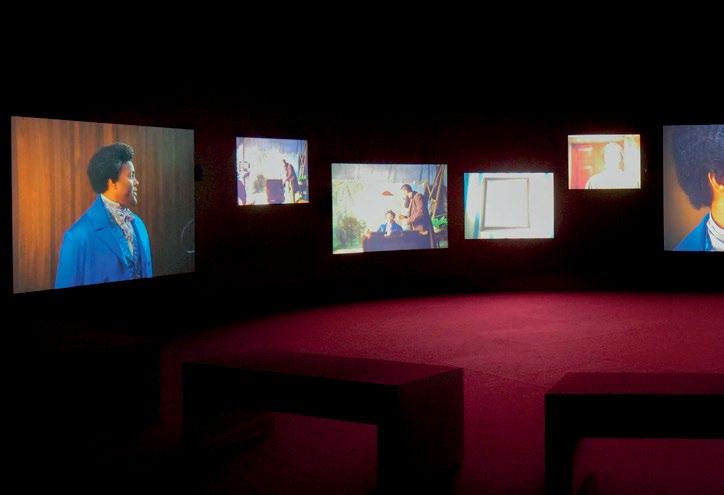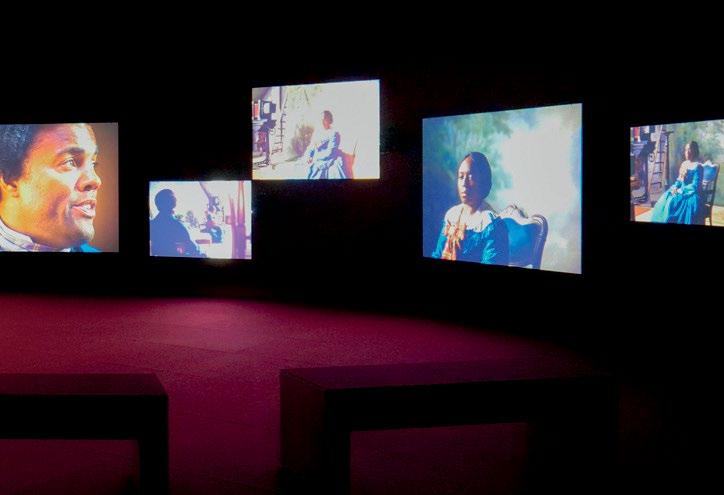
4 minute read
The Crawl Space
Bruce Slatter
A little over twenty years ago, I spent some time snoozing in the roof space of this gallery. Up above the ceiling panels and out of sight, I reclined in the darkness. The crawl space was an ideal hiding spot and offered a moment of calm and respite, as tiredness and fatigue from long days of physical installation work started to take their toll.
Advertisement
The light from the gallery below created a bright grid on the ceiling. From my unusual vantage point, the video work below created strips of blue hue between the square panels. It made my ceiling panel like a raft in an enveloping darkness. I closed my eyes to block out the light and the afterglow of the grid gave me the sense I was in a Tron-like video game. As the light diminished from the back of my retina, I thought about the video work being installed below.
The artwork was a two-projection video installation called Around Now by the Irish artist Grace Weir. It was an aerial portrait of a cloud filmed from a small plane as it flew around the cloud. The opposing screen showed the view out the other window of the plane, as if looking from the cloud’s perspective and across what looked like bucolic green fields of the Irish countryside. Around Now was a work about the slippage that occurs between two viewpoints, with the video installation creating a physical and conceptual ‘space in-between’ that the viewer could inhabit.
From my viewpoint in the ceiling, the slippage I was experiencing, was a ‘space in-between’, being semi-awake and being in deep, deep sleep. As I thought about the large, white, soft, fluffy cloud on show in the gallery, I thought about sleep and about art.
I recalled the 1995 artwork at the Serpentine Gallery called The Maybe. Conceived by Tilda Swinton in collaboration with Cornelia Parker, the artwork took the form of Swinton sleeping in a vitrine, eight hours a day, for seven days. The work was of course controversial, at least in the media at the time. Swinton slept through the criticism as if in training for a sleep competition.
At that moment in the roof, I felt like every misguided art critic who looks at an artwork and says, ‘I could do that’. Sleeping for a week like Tilda Swinton, I could definitely have done that.
I enter these gallery spaces, not purely as a viewer with an interest in art nor even as an art academic. First and foremost, I come to this space as an installer. It’s not quite Charles Bronson in ‘The Mechanic, but ‘The Installer’ does have a filmic ring to it.
As an ex-installer, I want to know how the work exists in the space, before finding out what it is or what it means. The skills and tricks of installation are usually not meant to be noticed by the viewer, with the emphasis of experience on the artwork. For me, figuring out the logistics and techniques of installation can be integral to the understanding of art. I think it gets me closer to the intention of the artist and makes me feel like they have got to this point through a sophisticated process of trial and error. The brief moments of investigation, aka ‘nosing around’, don’t lessen the power of the work, it just delays the moment of my focus on the work itself.
My fascination with a new exhibition, particularly here at the John Curtin Gallery, begins with the way the curator and installers have organised the physical transference from the previous space. It’s the way the light changes and the sounds are muffled, for video work, it’s the physical preparation for a cinematic experience, but without the aroma of stale popcorn.
I entered the gallery space to see Isaac Julien’s video work, Lessons of the Hour, in the usual way. Despite trying to look at how the screens were hanging in space, and the type of video projectors being used, I couldn’t take my eyes from the images themselves. Julien’s work about Frederick Douglass demands attention. At times, each of the ten screens focus on independent imagery, depicting subject and context, then suddenly all screens combine to emphasise the importance of the same visual moment, like the mechanism of the steam train moving across the screens and through the gallery.

For a viewer, it is impossible to give all ten screens equal attention, as if the importance of the subject matter is too much to completely comprehend. Julien uses this visual slippage, shifting from a first-person view, like sneaking through a house, to a third person observation of the character of Douglass. Julien places the viewer there in history, to bear witness. The cracking of the whip amongst the cotton harvest and the ominous creaking of a taut rope in the pine tree, shock the viewer to attention.
What can we do in the presence of such powerful work like Isaac Julien’s Lessons of the Hour? Well, we should allow ourselves to be jolted out of inertia, and be forced to sit up and take notice. Through the beauty and focus of an artist’s vision, Julien asks us to witness a recreation of Douglass, embodying the fight against injustice. The Douglass character leads the horse, as he leads us, through the landscape, always with a destination or end goal in mind. In this artwork, Julien asks us to respect and honour the legacy of Frederick Douglass, and to never forget.
Great art has the ability to lift us all up; it teaches us and inspires us. Sometimes, like in Julien’s video installation, it wakes us up, drags us from the darkness of the crawl space, and demands that we see the light.
Author’s note
Isaac Julien’s artwork, Lessons of the Hour, is an engaging multi-screen installation about the abolitionist Frederick Douglass. Each of the 10 screens combine to highlight aspects of Douglass’ life through staged re-enactment. The artwork is immersive and evocative, and despite the powerful meaning of the artwork, as an artist and former art installer, I found myself musing on how the artwork was made and how it was installed.
Bruce Slatter is Deputy Head of School and Discipline Lead of the Creative Arts in the School of Media, Creative Arts and Social Inquiry at Curtin University. He has worked at Curtin in a range of academic and professional roles since 2000 including as an installer at the John Curtin Gallery. Bruce is a practicing artist and is a previous winner of the Bankwest Art Prize (sculpture), Sculpture by the Sea (Cottesloe) and the Woollahra Small Sculpture Prize. He has work in several public collections, including the Art Gallery of Western Australia, Artbank and the Bankwest Art Collection.








